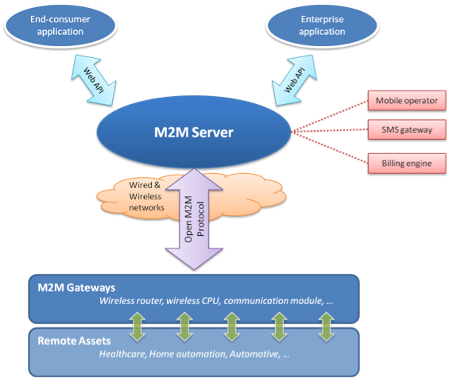Open source Eclipse group aims to standardize M2M communications
Nov 1, 2011 — by Eric Brown — from the LinuxDevices Archive — 4 viewsSierra Wireless and the Eclipse Foundation announced an Eclipse working group to define an open development standard for machine-to-machine (M2M) communications. Together with founding members IBM and Eurotech, the M2M Industry Working Group will establish an integrated development environment for M2M networks, as well as a Linux-based, lightweight communications protocol, based in part on Sierra Wireless' Koneki project and the Lua scripting language.
The M2M Industry Working Group is a new umbrella organization for M2M-related open source Eclipse projects that will attempt to unify the growing number of incompatible and overlapping M2M platforms and protocols. It will drive innovation, as well as reduce maintenance and upgrade problems, by standardizing on open source tools, protocols, interfaces and application programming interfaces (APIs) for M2M, the founder members said in a Nov. 1 release.
One specific goal of the the M2M Industry Working Group is to develop an integrated development environment (IDE), based on the Lua scripting language. This will also presumably borrow from the Eclipse IDE, the most notable project among the Eclipse Foundation's collection of over 200 open source projects.
Another related goal is the creation and the maintenance of a standard, Linux-based, implementation of a lightweight communication protocol supporting two-way communication between devices and servers. The group will also create and maintain a compatibility test suite to enable validation of compliant implementations.
Koneki taps Lua
The group's flagship project is the Koneki project, already launched by Sierra Wireless. The company is known for making equipment often used in M2M networks such as wireless routers and Linux-ready embedded wireless modules. Koneki's open source tools and APIs include development, simulation, testing/debugging, and deployment solutions for M2M across multiple environments and standard communications protocols.
Based in part on Sierra Wireless' AirVantage M2M Cloud Platform, the tools are said to support Linux and Java, while also interacting with proprietary environments such as Sierra Wireless' own Open AT OS platform. Sierra Wireless' major Koneki contribution to date is an embedded development environment built around the Lua programming language.
Lua is a fast, lightweight scripting language typically used in game development, among other segments. Google's Android Scripting Environment offers support for Lua, among other supporting development platforms.
Sierra Wireless and the Eclipse Foundation made the M2M announcement at EclipseCon Europe being held this week in Ludwigsburg, Germany. In addition, IBM and Eurotech have signed on as founding members. The group is said to be open to any interested organization, including both vendors and potential clients, in industries where machine-to-machine communications are on the rise.
The working group is the second major new open source communications project announced this week along with the Linux Foundation's financial services oriented OpenMAMA messaging project.
Stated Angel Diaz, vice president, software standards, IBM Software Group, "The Eclipse Machine-to-Machine Industry Working Group and the related open source projects will enable customers to integrate physical world systems into their enterprise solutions."
Stated Mike Milinkovich, Executive Director of the Eclipse Foundation, "The open source contributions of M2M tools and protocols will help to reduce development time and costs, and ensure that mission critical systems maintain interoperability as deployments evolve over the lifetime of a project."
M2M background
M2M describes technology in which semi-autonomous machines communicate with each other, typically over wireless networks. M2M devices are found in applications such as smart metering, energy management, inventory control, fleet management, healthcare, and security.
M2M devices range from fairly simple sensors, actuators, and controllers, to more advanced devices such as digital signage and security systems that run on Linux and other high-end operating systems. M2M devices often need to communicate with each other, as well as link to an often Linux-based IT infrastructure that aggregates physical world events from devices with enterprise and web applications.

Typical M2M network
Source: M2M Industry Working Group (Eclipse Foundation)
(Click to enlarge)
In addition, the M2M server infrastructure must often be interfaced with other information systems, ranging from SIM card subscription management or billing to enterprise cargo tracking and vehicle maintenance systems.
Availability
More information on the Eclipse Foundation's M2M Industry Working Group may be found on this Sierra Wireless Koneki project page as well as the Eclipse Foundation's Koneki project site and the foundation's M2M working group charter page.
This article was originally published on LinuxDevices.com and has been donated to the open source community by QuinStreet Inc. Please visit LinuxToday.com for up-to-date news and articles about Linux and open source.